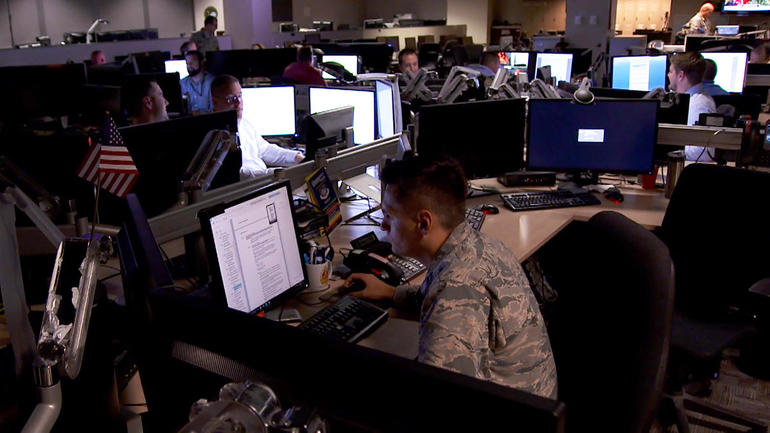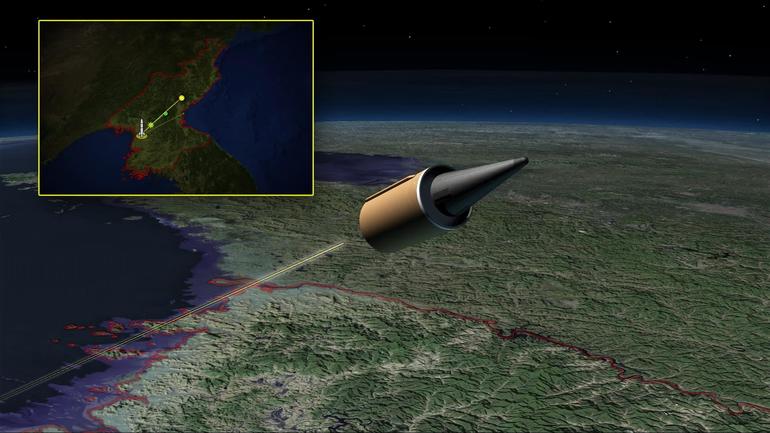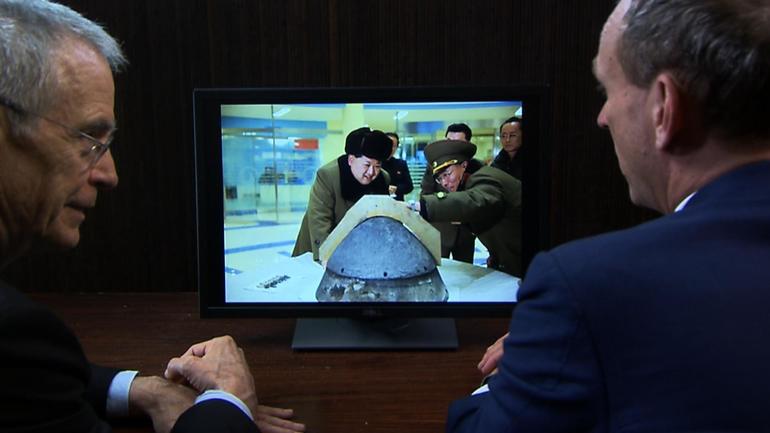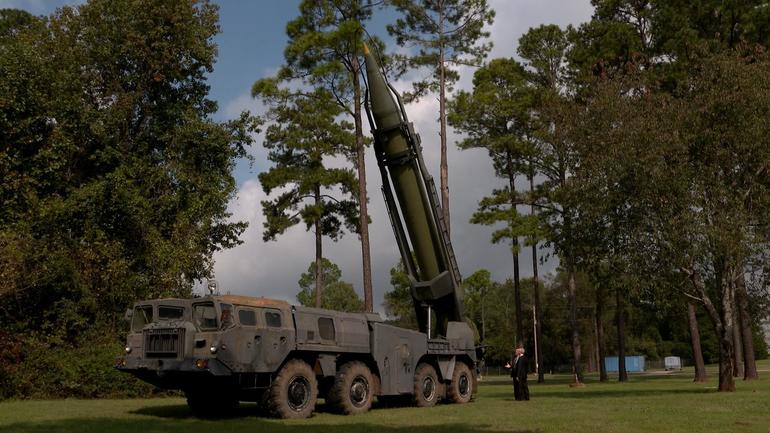After years of threatening to burn the United States in a sea of fire, North Korea is on the verge of having an intercontinental ballistic missile — an ICBM — capable of hitting the American homeland with a thermonuclear warhead. The missile is called the Hwasong — which translates to Mars, the Roman God of War.
North Korea’s brash, young dictator Kim Jong Un is not there yet and will need several more tests before he has a weapon he can count on. Still, the chairman of the Joint Chiefs calls it the greatest threat facing the U.S. today. Defense Secretary James Mattis went to the DMZ two days ago and vowed to stand with South Korea against the north.
Tracking that threat, and helping to come up with defenses against it, is the job of the National Air and Space Intelligence Center, NASIC for short, located near Dayton, Ohio. If you’ve never heard of NASIC, that’s because television news cameras have never been inside its operations center — until now.

National Air and Space Intelligence Center
CBS News
On any given day at NASIC more than 100 photo interpreters, engineers, rocket scientists and intelligence analysts are poring through reams of data collected every time North Korea launches a missile. Last summer, the North Korean threat went to a whole new level, says NASIC Commander Col. Sean Larkin.
Col. Sean Larkin: They demonstrated the ability that they could reach the continental United States.
David Martin: The lower 48?
Col. Sean Larkin: Yes.
There were two tests — one on July 4 and again on July 28. Both were launched at a very high angle, so they did not go far out to sea. But once NASIC crunched the numbers there was no doubt had one of those missiles been fired on a standard trajectory it could have reached California and beyond.
Col. Sean Larkin: Math is our secret weapon So there’s lots of things that go into an ICBM or other types of weapons systems that simply — even if we don’t have the pieces of the puzzle we can do the math and figure out what’s missing.
Jeremy Suel and his team of analysts produced a computer simulation of North Korea’s ICBM.
Jeremy Suel: Well, this is the actual code that we develop.
David Martin: So, can you take me through what this would look like on a flight?
Jeremy Suel: Yes.

A computer rendering of the Hwasong (God of War) missile
NASIC
This is the God of War, North Korea’s intercontinental ballistic missile.
Jeremy Suel: The first stage of the system is there to get it off the ground, get initial motion. But then it will drop that stage.
After the Hwasong 14’s engines have sent it into space all that is left is the re-entry vehicle. A warhead would be inside as gravity pulls it back to Earth.
Jeremy Suel: You’re at the mercy of the atmosphere at that point. You’re slamming into it at many, thousands of miles per hour, so that will have tremendous forces imparted on the, the reentry vehicle.
David Martin: And what kind of temperatures are we talking about?
Jeremy Suel: Many thousands of degrees.
North Korea cannot attack the U.S. with a nuclear weapon until it develops a reentry vehicle that can stand that kind of heat.
Hugh Griffiths is head of the team which monitors the North Korean missile program for the U.N. Security Council. He says pictures released by the regime last year were an attempt to prove it had already succeeded. A reentry vehicle was subjected to a rocket engine blast.
“The whole thing is inconceivable and out of, like, some bad science fiction film. [Kim Jong Un] is intimately connected with the whole program, and this is very deliberate — and very unusual.”
David Martin: Is that a realistic test?
Hugh Griffiths: We assessed that it wasn’t sufficiently realistic to be credible.
David Martin: Because the rocket engine does not create enough heat?
Hugh Griffiths: Correct. The heat produced by the rocket engine is not sufficient to mimic what this would experience reentering the earth’s atmosphere.
North Korea released a picture of the scorched reentry vehicle. And one of its 33-year-old leader Kim Jong Un being shown how little had been burned away.

Correspondent David Martin and Hugh Griffiths sit before a picture of Kim Jong Un observing a reentry vehicle
CBS News
Hugh Griffiths: The idea of this narrative is to prove that yet another requirement of the nuclear ballistic missile program has been achieved.
David Martin: Kim Jong Un seems to be everywhere. Does it strike you as unusual that you would have a head of state inspecting a reentry vehicle?
Hugh Griffiths: Yeah. The whole thing is inconceivable and out of, like, some bad science fiction film. The man is intimately connected with the whole program, and this is very deliberate — and very unusual.
Almost all of North Korea’s missiles — from long range down to short range — are carried on mobile launchers.

Short-range Scud at the Missile and Space Intelligence Center in Huntsville, Alabama
CBS News
This is a short-range Scud, developed by Russia in the 1950s and sold to countries all over the world. This one belongs to the Missile and Space Intelligence Center in Huntsville, Alabama.
Senior Intelligence Analyst Steve Hancock says the Scud can be launched straight off the back of this truck.
Steve Hancock: This is a Russian Scud B. It’s mobile, and even to this day, it’s a very challenging aspect of the missile force for us to deal with.
David Martin: A moving target is harder to hit.
Steve Hancock: Yes sir.
David Martin: And…
Steve Hancock: It’s harder to find as well.
Hancock says a well-trained crew can raise, aim and fire a Scud in 18 minutes.
David Martin: Do they use these exact same procedures if they’re launching a longer-range missile?
Steve Hancock: Yes. They’re gonna be very similar.
David Martin: And is the — the launch time still about 18 minutes?
Steve Hancock: So, the bigger the missile gets, it’s probably gonna get to be a little bit slower. But we don’t know the exact launch times for all of the systems.
Inside the Missile and Space Intelligence Center, there’s another Scud laid out like a corpse on an autopsy table.
Marie — we agreed not to use her last name — is a missile engineer whose job is to know as much about the Scud as the people who built it.
Marie: These are graphite rudders that sit in the exhaust of the missile and are used to steer the missile. This is the instrument section where the guidance equipment sits. So there’s a lot of complex equipment in here.
David Martin: Is that part made of what it looks like it’s made of?
Marie: Plywood, yes it is
David Martin: Plywood…
Marie: It saves a lot of weight putting that wood in there instead of metal.
David Martin: Plywood just doesn’t sound like rocket science.
Marie: You know, it doesn’t feel that way to us as westerners They don’t invest resources where it’s not necessary.
It only has a range of 186 miles, but it would reach its target in about five minutes.

Correspondent David Martin and a missile engineer with a Scud missile
CBS News
Marie: So, then we get up to the real serious part of this missile which is what we call the payload. The payload is everything including the warhead that sits inside this cavity. It can carry about 1,000 kilograms or 2,200-pound payload.
But here’s the feature that sets this Scud apart.
Marie: This was designed to be a nuclear trainer and you can tell because the thickness of the aero-shell here is more than what it would be for a standard high explosive warhead.
David Martin: A nuclear trainer? This missile is capable of carrying a nuclear warhead?
Marie: This missile as designed by Russia was intended to carry a nuclear warhead.
David Martin: A nuclear-capable weapon with a five minute flight time, it doesn’t give you much time to react.
Marie: It doesn’t give you much, does it?
Last March, North Korea launched a salvo of four Scuds simultaneously in what it said was a drill to attack U.S. military bases.
David Martin: What’s the purpose of firing a salvo of missiles.
Scott MacDonald: Well, so a salvo is intended to overwhelm your defenses.
Senior Weapons Analyst Scott MacDonald took us into the computer simulation center to show how missiles like those would perform in flight.
Scott MacDonald: So, as the videos from North Korea end, when they go into the clouds, we’re able to represent the entire flight of the missile by putting this into a digital representation. And this looks a lot like a cartoon or a video game, but this is really a lot different. There’s a lot of hard science and math that goes behind this.
At this point, the only defense would be to shoot them down which is why these computer simulations go into so much detail.
David Martin: So this is reverse engineering.
Scott MacDonald: Exactly.
David Martin: That’s what would happen as it was re-entering.
Scott MacDonald: Correct. So it’s showing kind of a tumbling motion and you can see the pressure waves coming off of that missile… That’s the aerodynamic forces that are acting on that missile and that’s how we understand how it’s going to fly.

Senior Weapons Analyst Scott MacDonald and correspondent David Martin view a computer simulation showing how certain missiles would perform in flight
CBS News
The Scud can reach targets in South Korea where 28,500 American troops are based. Another North Korean missile called the Nodong has a great enough range to hit Japan where 54,000 American servicemen are stationed.
Mark Clark: It’s a scaled-up Scud missile.
Mark Clark is director of the Military and Space Intelligence Center.
David Martin: Japan and South Korea and all the Americans living there are already in range of nuclear capable missiles?
Mark Clark: They’re certainly in range of Scud and Nodong class missiles. Absolutely.
David Martin: How many Scud and Nodong class missiles do the North Koreans have?
Mark Clark: Hundreds.
David Martin: Hundreds?
Mark Clark: Yes.
Clark would not discuss classified intelligence about North Korea, but he did tell us this.
Mark Clark: We have insights today that we didn’t have a few years ago.
David Martin: Such as
Mark Clark: I’m hesitant to go into sources and methods except to say there are opportunities we’ve had to observe and learn about the ballistic missile threats there.
In February 2016 the U.S. and its allies got their hands on another missile, this time a long-range one, part of a rocket North Korea used to launch a satellite into orbit.
Hugh Griffiths: The satellite never really functioned. It wasn’t a serious satellite, but it was a serious rocket.
The U.N.’s Hugh Griffiths says that rocket was really a test vehicle for an intercontinental ballistic missile, and a large part of it fell into the sea.
Hugh Griffiths: The South Korean Navy got to this location, and when debris fell from the sky they were able to recover some of that debris and invited us to inspect it.
David Martin: So you physically got your hands on some of the components that had been used.
Hugh Griffiths: Yes, we were very lucky. We were able to photograph the debris, take it apart and run checks on the serial numbers of quite a variety of components.
In the past two years, North Korea has conducted more than 40 test launches, virtually every one of them personally approved and supervised by Kim Jong Un.
“An ICBM has a reentry velocity on the order of four to five miles per second, so there’s very little time to react.”
Tom Boyd: What’s he’s shown is that he has a tolerance for failure.
Tom Boyd, senior intelligence analyst for ballistic missiles at the Air and Space Intelligence Center, means that as a compliment.
Tom Boyd: If you are not willing to fail in the ballistic missile or space launch vehicle missiles business, you’re in the wrong business… It’s almost inevitable, these are highly complex systems, and failures are pretty much inevitable.
David Martin: 2016 saw a lot of failures.
Tom Boyd: I can’t recall the exact number, but he did have significant failures.
David Martin: And not so many this year.
Tom Boyd: He’s having much, much better success this year.
David Martin: So, it just looks like they’ve figured something out.
Tom Boyd: Yes, I think they have learned from their failures.
What North Korea figured out is a high thrust engine and a high-performance fuel to power it.
David Martin: Would you say that engine and that fuel is responsible for their recent successes?
Tom Boyd: They seem to be getting good performance, yes.
The Pentagon says it is confident its missile defense system — 42 interceptors based in Alaska and California — can shoot down a North Korean ICBM, although the test record shows only a 55 percent success rate.
Last May it shot down this mock North Korean missile which was designed from models developed by the Air and Space Intelligence Center. Despite that most recent success, ICBMs are what Boyd calls “a challenging target.”
Tom Boyd: They’ve been referred to as the ultimate weapon. They get to the target very quickly. An ICBM has a reentry velocity on the order of four to five miles per second, so there’s very little time to react.
So how long before North Korea can really threaten the American homeland with an ICBM?
Tom Boyd: Probably several more flight tests, but ultimately if they want to have confidence that the system works as intended they have to flight test it and prove that reentry vehicle can survive realistic reentry conditions.
David Martin: So that really is then the moment of truth when they launch, if they launch, a ballistic missile out over the Pacific Ocean at a range approximating what it would take to reach the United States.
Tom Boyd: That would give them higher confidence that the system really works as they want it to.
At the rate North Korea is testing, U.S. intelligence estimates that could happen as early as next year.
Produced by Mary Walsh. Tadd J. Lascari, associate producer.
